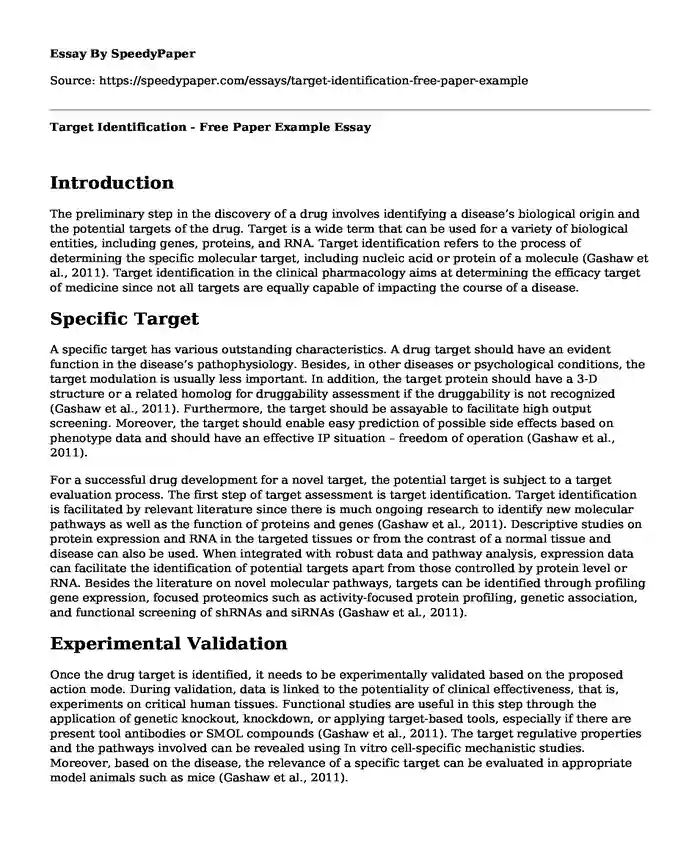Introduction
The preliminary step in the discovery of a drug involves identifying a disease’s biological origin and the potential targets of the drug. Target is a wide term that can be used for a variety of biological entities, including genes, proteins, and RNA. Target identification refers to the process of determining the specific molecular target, including nucleic acid or protein of a molecule (Gashaw et al., 2011). Target identification in the clinical pharmacology aims at determining the efficacy target of medicine since not all targets are equally capable of impacting the course of a disease.
Specific Target
A specific target has various outstanding characteristics. A drug target should have an evident function in the disease’s pathophysiology. Besides, in other diseases or psychological conditions, the target modulation is usually less important. In addition, the target protein should have a 3-D structure or a related homolog for druggability assessment if the druggability is not recognized (Gashaw et al., 2011). Furthermore, the target should be assayable to facilitate high output screening. Moreover, the target should enable easy prediction of possible side effects based on phenotype data and should have an effective IP situation – freedom of operation (Gashaw et al., 2011).
For a successful drug development for a novel target, the potential target is subject to a target evaluation process. The first step of target assessment is target identification. Target identification is facilitated by relevant literature since there is much ongoing research to identify new molecular pathways as well as the function of proteins and genes (Gashaw et al., 2011). Descriptive studies on protein expression and RNA in the targeted tissues or from the contrast of a normal tissue and disease can also be used. When integrated with robust data and pathway analysis, expression data can facilitate the identification of potential targets apart from those controlled by protein level or RNA. Besides the literature on novel molecular pathways, targets can be identified through profiling gene expression, focused proteomics such as activity-focused protein profiling, genetic association, and functional screening of shRNAs and siRNAs (Gashaw et al., 2011).
Experimental Validation
Once the drug target is identified, it needs to be experimentally validated based on the proposed action mode. During validation, data is linked to the potentiality of clinical effectiveness, that is, experiments on critical human tissues. Functional studies are useful in this step through the application of genetic knockout, knockdown, or applying target-based tools, especially if there are present tool antibodies or SMOL compounds (Gashaw et al., 2011). The target regulative properties and the pathways involved can be revealed using In vitro cell-specific mechanistic studies. Moreover, based on the disease, the relevance of a specific target can be evaluated in appropriate model animals such as mice (Gashaw et al., 2011).
Once a target is validated, it is subsequently subjected to protein druggability. Protein druggability can be explored through methods of examining sequence-related characteristics of proteins and methods of examining the protein 3-D structures. Drug targets having a recognized 3D-structure can be assessed from the Potential Drug Target Database, which has over 1207 entries for 841 recognized and potential structured drug targets acquired from the Protein Data Bank. A recognized 3D-structure facilitates the drug target assessment through the estimation of possible binding areas for SMOLs (Gashaw et al., 2011).
The last step of drug assessment involves the assayability evaluation. The function and binding biochemical and cellular assays are essential in facilitating a late stage screening session for an appropriate lead compound. The possibility of developing a significant assay is based on the information and class of the target. Since activity status of multiple GPCRs is easily monitored through the quantities of levels of the second messenger, an astray GPCR target is anticipated to have a positive assayability. Conversely, a single GPCR could potentially produce low assayability regardless of questionable druggability. In such a case, functional studies can be formatted into relevant pharmacology assays (Gashaw et al., 2011).
Conclusion
In conclusion, there are various perspectives on the selection of drug target relating to the amount of the clinical area, unfulfilled need, competition, validation, and intellectual property.. Above all, a thoroughly implemented target validation significantly helps in minimizing rates of attrition in the late phases of drug development. Accordingly, appropriate BIOL and SMOL against a novel drug target are unnecessary when the early hypothesis of disease is invalid.
References
Gashaw, I., Ellinghaus, P., Sommer, A., & Asadullah, K. (2011). What makes a good drug target? Drug discovery today, 16(23-24), 1037-1043.
https://doi.org/10.1016/j.drudis.2011.12.008.
Cite this page
Target Identification - Free Paper Example. (2023, Nov 24). Retrieved from https://speedypaper.net/essays/target-identification-free-paper-example
Request Removal
If you are the original author of this essay and no longer wish to have it published on the SpeedyPaper website, please click below to request its removal:
- Essay Example: Designing a New City and City Branding
- Essay Example on Cost of Medical Error
- Cardiac Rehabilitation Program, Healthcare Essay Example
- Essay Sample Describing Employees Engagement in Patient Experience
- Essay Example: Group Processes and Stage Formation
- The Significance of Lifestyle Habits on the Acquisition of the Spanish Flu - Essay Sample
- Human Papillomavirus Infection among Teenage and Middle-Aged Women - Paper Example
Popular categories





